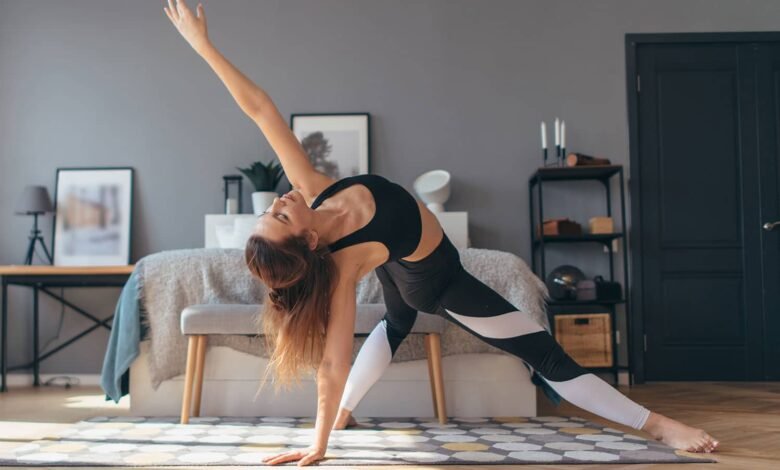VINYASA YOGA: THE FLOWING HARMONY OF BREATH AND MOVEMENT
VINYASA YOGA: THE FLOWING HARMONY OF BREATH AND MOVEMENT

Vinyasa Yoga, often referred to as “flow” yoga, is a dynamic style of yoga that synchronizes movement with breath to create a continuous flow of postures. Originating from the ancient teachings of yoga in India, Vinyasa Yoga embodies the philosophy of connecting the mind, body, and spirit through intentional movement and breath awareness.
Benefits of Vinyasa Yoga
The practice of Vinyasa Yoga offers a multitude of benefits for both the body and mind. Physically, it improves strength, flexibility, and cardiovascular health. Mentally, it promotes stress relief, mental clarity, and emotional balance.
Vinyasa yoga traces its roots back to ancient India, where it was first mentioned in the Yoga Sutras of Patanjali, a foundational text on the philosophy and practice of yoga. However, the modern iteration of vinyasa yoga is attributed to the renowned yoga teacher Krishnamacharya, who developed a dynamic style of yoga known as Vinyasa Krama in the early 20th century. His teachings were later popularized by his students, including B.K.S. Iyengar and T.K.V. Desikachar, who played instrumental roles in spreading vinyasa yoga to the Western world.
The Flowing Harmony of Breath and Movement
Central to Vinyasa Yoga is the seamless integration of breath and movement. Each movement is linked with either an inhale or an exhale, creating a rhythmic and meditative flow. This union of breath and movement fosters a sense of harmony and presence on the mat.
What is Vinyasa Yoga?
Vinyasa yoga derives its name from the Sanskrit words “vi,” meaning “in a special way,” and “nyasa,” meaning “to place.” In essence, it refers to the mindful coordination of breath and movement as one transitions from one yoga pose to another. Unlike more static forms of yoga, such as Hatha, where poses are held for longer durations, vinyasa yoga emphasizes the fluidity and rhythm of movement.
Principles of Vinyasa Yoga
In Vinyasa Yoga, practitioners follow specific principles to guide their practice. Breath-synchronized movement is key, with each inhale and exhale corresponding to a specific movement or transition. Sun Salutations, a series of poses performed in a flowing sequence, are often used as the foundation of Vinyasa practice. Additionally, practitioners learn to build sequences that flow smoothly from one pose to the next, creating a dynamic and fluid practice.
Getting Started with Vinyasa Yoga
For those new to Vinyasa Yoga, finding the right class is essential. Look for beginner-friendly classes that focus on alignment and breath awareness. Basic poses such as Downward-Facing Dog, Warrior Poses, and Child’s Pose are excellent starting points for building strength and familiarity with the practice.
Advanced Practices in Vinyasa Yoga
As practitioners progress in their Vinyasa practice, they may explore more advanced sequences and poses. Challenging sequences challenge both strength and flexibility, while inversions and arm balances offer opportunities for growth and exploration on the mat.
Tips for a Successful Vinyasa Practice
To get the most out of your Vinyasa practice, it’s important to listen to your body and honor its limitations. Focus on the breath as a guide, allowing it to lead you through each movement with intention and awareness. Stay present on the mat, letting go of distractions and tuning into the sensations of the body.
Common Misconceptions about Vinyasa Yoga
Despite its many benefits, Vinyasa Yoga is often misunderstood. One common misconception is that it’s too fast-paced for beginners. While Vinyasa classes can be energetic, practitioners are encouraged to move at their own pace and modify as needed. Another misconception is that Vinyasa Yoga is only for the flexible. In reality, Vinyasa practice can be adapted to suit practitioners of all levels and abilities.
Principles and Philosophy
At the heart of vinyasa yoga are three key principles: breath control (pranayama), posture (asana), and the integration of body, mind, and spirit. Pranayama techniques, such as Ujjayi breath, are used to regulate the breath and cultivate internal heat, while asanas are performed with precision and mindfulness to promote strength, flexibility, and balance. The practice of vinyasa yoga is also guided by the philosophical teachings of yoga, which emphasize self-awareness, compassion, and liberation from the fluctuations of the mind.
Conclusion
Vinyasa Yoga offers a powerful journey of self-discovery and transformation through the union of breath and movement. By cultivating a flowing harmony on the mat, practitioners can experience physical vitality, mental clarity, and emotional balance.


